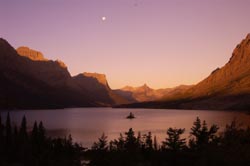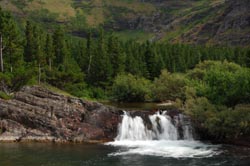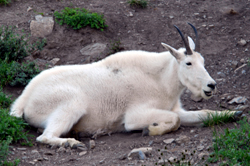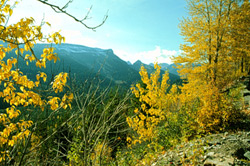Glacier National Park
Updated: August 18, 2020

Montana's Glacier National Park is 1.2 million acres of shining mountain ranges, deep valleys, and lakes carved by prehistoric ice rivers. The park features 60 glistening glaciers, alpine meadows, dense forests, waterfalls, majestic hanging valleys, and over 200 sparkling lakes. Set in a rugged section of the northern Rockies, Glacier National Park joins Waterton Lakes National Park in Alberta Canada to form Waterton-Glacier International Peace Park. Glacier is the third largest National Park in the lower 48 states.
The park is home to 936 miles of rivers and streams and over 700 miles of hiking and walking trails. Relatively few miles of roads exist in Glacier, thus preserving its primitive and unspoiled beauty. The exception is the scenic Going-to-the-Sun Highway, which winds through the center of the park. The breath-taking, 52-mile highway crosses the Continental Divide at Logan Pass and traverses the towering Garden Wall. The remarkable red "Jammer" tour buses run daily (summer and early fall months) along this spectacular route.
Glacier National Park straddles the Continental Divide from Canada in the north to Marias Pass, Montana in the south. Heavy snows in the winter and melt from the many glaciers feed crystal- clear streams. These streams form the headwaters of three of North America's major river systems: the Missouri/Mississippi, the Columbia, and the Saskatchewan/Nelson.

Waterton-Glacier International Peace Park protects an important habitat at the point where the Rocky Mountains reach their narrowest width. The two Parks support an exceptionally diverse and productive environment, reflected by abundant populations of large mammals and carnivores (meat-eating animals), including wolves, grizzly bears and mountain lions.
Glacier National Park is the only location in the lower 48 states where these three predator populations still occur naturally. Additionally, the wilderness areas north and south of Glacier (Bob Marshall-Great Bear-Scapegoat Wilderness) provide a protected area for the movement of plant and animal species along the Continental Divide.
This feature is ideal for bio-diversity, the existence of a wide range of different types of plants, animals, birds, and insects in a given place at a given time. Not surprisingly when we think of bio-diversity we find it easier to identify with some species such as large mammals (elk, bear, deer), birds, and trees, than with others, like bugs, slugs, and molds. You might find it interesting that Glacier martens (a slender-bodied carnivorous mammal that is larger than the related weasel) are host to over 13 or more species of fleas, ticks, worms, and mites. We must remember the term wildlife refers to all living things, not just large mammals. While most of Glaciers species have been cataloged, scientists recently found four butterfly species that had never been recorded.

Researchers from around the world come to study the unique geology of Glacier Park. The park provides geologists with information about similar processes that are occurring in the Andes and Himalaya mountains. This is due to the preservation of the ancient rock, the recent glacial sculpturing of the rocks, and the accessibility of the park. One hundred and seventy million years ago the earth's crustal plates began to collide. This created the Lewis Overthrust.

Thanks for visiting the Montana Kids' Site! We hope you've found the information both educational and entertaining. If you have comments or suggestions on ways we can improve the site please send us email at montanakids@visitmt.com.
You can also help your family plan a trip to Montana. Have your folks request a statewide travel packet by clicking here.

